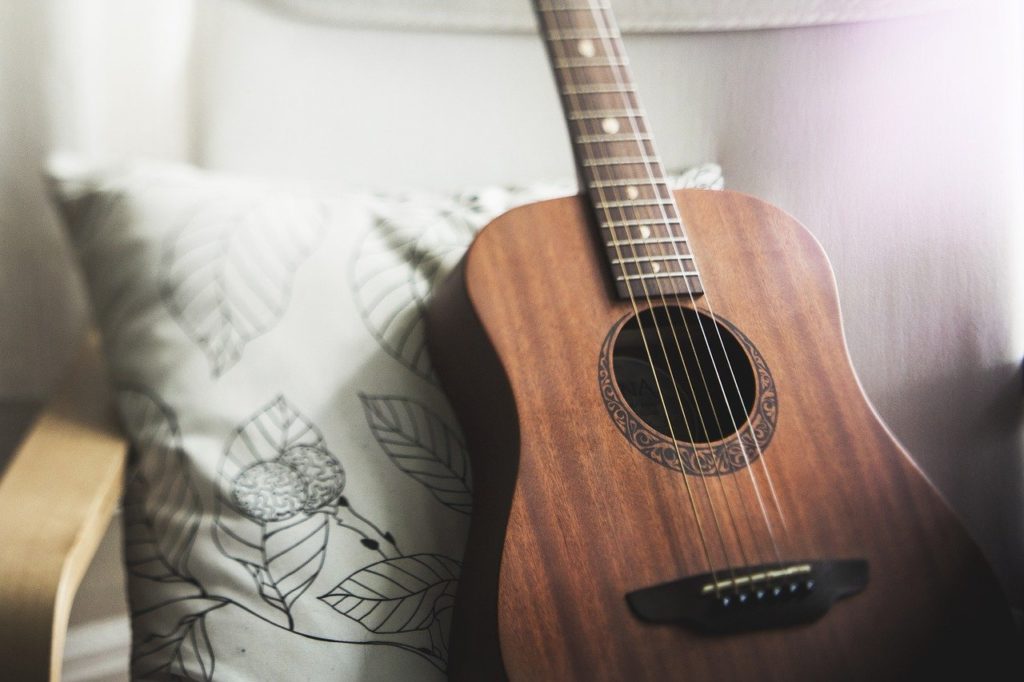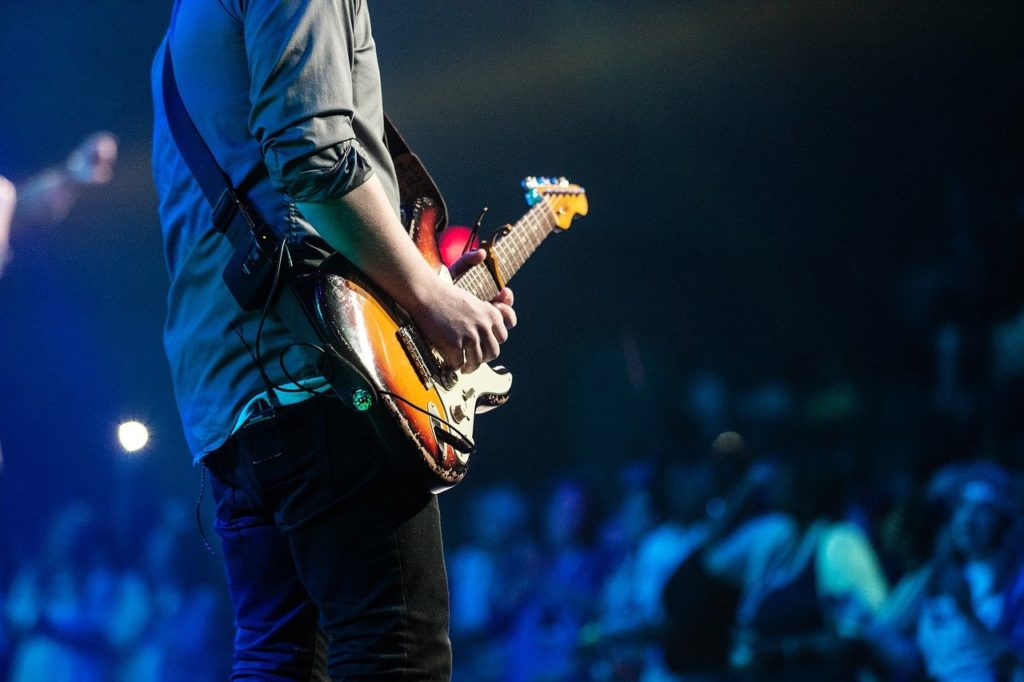Are you a fan of B.B. King? What about Jimi Hendrix or Amy Winehouse? If you like these artists or others like them then C minor may be the scale for you. Before we dive deep into everything let’s start at the beginning.
What are the notes of the C Minor Scale?

C
D
Eb
F
G
Ab
Bb
The C Minor Scale on Guitar
The C minor scale is a heptatonic scale, meaning it consists of 7 unique notes. All minor scales are derived from their parallel major scale. To get this derivative of C major you apply a formula. The formula for the minor scale is 1, 2, b3, 4, 5, b6, b7. I’ll explain this more in a later section.
Let’s look at how the notes lay out on the fretboard of a guitar.

In figure 1 the notes of the C minor scale are laid out from the 1st fret to the 15th. You’ll notice at the 13th fret the pattern starts to repeat itself. The note at the 13th is an octave of the tonic on each string. To help understand this remember the minor scale is heptatonic. If you start from the notes on the 1st fret you can count 7 notes before the octave repeats at the 13th.
You want to memorize the notes of the fretboard. There are plenty of methods to do thisbut I like to recommend the CAGED Method. It’s applicable across multiple scales and it’s relatively easy to remember the shapes once you know how they’re developed.
How Do You Play the C Minor Scale on Guitar?
The Caged Method is broken up into 5 positions, one for each letter of the word CAGED.Each position corresponds to the open chord of each letter. In figure 2 I’ll display the notes on the fingerboard instead of just where they fall. We’ll then move further with tablature and the shapes of the CAGED system.

In the above figure you can now see which dot corresponds with what note in the C minor scale. It only goes to the 12th fret because as I pointed out the 13th fret repeats the notes of the 1st. Let’s simplify this by shrinking the fretboard down to a manageable size.

The 1st position of the C minor scale starts at the 8th fret. That is the first occurrence of the tonic on the 6th string. Now let’s have a look at how the CAGED Method directly applies to this position.

You can see how pattern 1 in figure 4 lines up exactly with the position from figure 3. If you refer to the image of the entire fretboard, you’ll see that each pattern from figure 4will match with the placement of the dots in the 1st and 2nd images.
Later in the solo section I’ll supply you with tablature to clear up any mystery that may be left. For now, let’s look at what makes up the C minor scale and why.
What Notes Are in the C Minor Pentatonic Scale?
All the scales in western music are pretty much tied together and they’re all rooted in the Major scale. The C minor scale is directly linked with 3 common scales. It has a pentatonic scale, a parallel major, and a relative major. The C minor scale has other derivatives called the Melodic and the Harmonic, but we’ll focus on the related Major scales.
First, let’s look at the C major scale as it all originates there. The C major scale is the easiest of the scales to notate as it has no sharps and no flats and ascend in alphabetical order. It consists of the following notes:
C
D
E
F
G
A
B
At the top of this lesson, I gave you a formula and here is where we will apply it. Just for a reminder the formula is 1, 2, b3, 4, 5, b6, b7. It will further help to show you the notes of the C minor scale again:
C
D
Eb
F
G
Ab
Bb
At a quick glance you can see the 1st, 2nd, 4th, and 5th notes are identical and it’s the 3rd, 6th, and 7th notes that change in pitch. That’s because of the applied formula. A flatted (b)note when used universally in a formula doesn’t always mean to make a note flat, it just means to take the note in that place back a half step or back one fret on a guitar.
Another scale that is directly related to the C minor is its relative major scale, not to be confused with the parallel major we just covered. The parallel major consists of different pitches but the same tonic, the relative major of C Minor has the exact same notes but a different tonic.
The relative major of C minor is Eb major. I’ll show you what I mean below, the notes of Eb are:
Eb
F
G
Ab
Bb
C
D
Eb
You can see the notes are identical to C minor. This can appear confusing to beginnersand if it is it don’t let it discourage you. Guitar players spend their entire lives learningmusic theory and how it applies to their craft.
For our purpose with the C minor scale just know the root note sets the tone. When you’re playing the C minor scale that tone is likely going to be melancholic and bluesy.
How Do You Solo with the C Minor Scale?
Minor scales sound great over minor chords and if there’s one thing musicians across the globe agree on it’s this, minors sound sad. It isn’t just musicians, listeners of music might not recognize it, but they surely feel it. If you play a C major chord is has a bright quality to it whereas if you play a C minor chord directly after you can hear a despondent character to it.
Sad, despondent, and melancholic aren’t words that typically evoke excitement, but they should because they can all be wrapped up in one word, one genre: Blues. All music can’t be about having a good time. It’s the Blues that really resonates with us all. So, let’s look at how to get some of that raw emotion out.
We’ve been over the CAGED method and how it applies to the fretboard. Now we’ll take all the work out of it and show you some C minor tablature that will get you playing immediately.

Starting with your index finger on the 8th fret on the low E string, pick the note and follow up with your ring finger on the 10th fand then the 11th frets. You will work yourself down towards the high E string using only leaving the 8th fret briefly to the 7th on the 3rdstring.
Once you hit the 11th fret on the first string repeat the process backwards until you end up back on the 6th string 8th fret. Again, you’ll want to start slowly until you’re comfortable with your accuracy on each note and increase your speed as you go.
Here is another section of tablature to work on before you must start applying the CAGED Method yourself.
With this tablature there’s some continuity with the last image. You’ll notice you’re again on the 10th and 11th frets at places. This will help you with some of the most common moves involved with soloing.
Use the links between the two to slide from one position to the next. Work on hammer-ons and pull-off that takes you through the different octaves of accompanying notes. Here is where you must improvise.
Use a track in the key of C minor. Next, take it a step further and record your own backing track, one that your familiar with intimately and can be comfortable with the timing and chord progressions.
Another option is to go with what you know works, previously released popular music in the key of C minor. Find your place in the song, learn the melody, and expand on it, creating a solo of your creation. Here are a few you can start with to choose from:
Once I Had a Woman by Jimi Hendrix
You Upset Me Baby by B.B. King
Get Up (I Feel Like a Sex Machine) by James Brown
And if you really feel like a challenge
Rolling in the Deep by Adele



